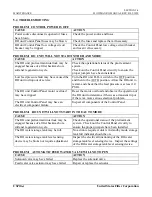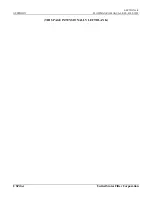
SECTION 5-5
MAINTENANCE
FLOWMAX RO MANUAL REV: B 05/1999
USFilter
United States Filter Corporation
PROBLEM: RO UNIT PRODUCTIVITY IS LOW
CAUSE
ACTION
RO unit operating pressure is too low.
Readjust the RO unit operating pressure.
RO unit product back pressure is excessive.
Check the pressure of the RO unit product plumbing,
it should not exceed 25 PSIG. If it does, determine
what is causing the pressure drop and reduce it.
RO unit feed water temperature is colder then
usual. (Lower feed water temperatures require
a higher operating pressure.)
Check the RO unit feed temperature. If it has
decreased, increase the operating pressure to
compensate for this low temperature operation.
RO unit membrane elements may be fouled.
Determine the nature of the foulant and clean and/or
sanitize the membrane elements.
Flowmeter readings not accurate.
Verify correct operation of flow sensors and flow
meters. Calibrate or replace if necessary.
RO pretreatment failure.
Inspect all pretreatment systems for problems.
PROBLEM: RO UNIT REJECTION IS LOW
CAUSE
ACTION
Inadequate operating pressure.
Increase RO unit operating pressure by further
opening pump discharge valve.
RO unit recovery is too high.
Reduce RO unit recovery to match values listed in
RO operating spec sheet in the Appendix.
Shift in feed water chemistry (oxidants in feed
water).
Check feed water chemistry. If substantially different
from the original design feed water chemistry, have a
new RO performance projection run to determine
what the rejection rate characteristic should be.
Mechanical leak in the membrane system.
Inspect all RO product tube adapter o-ring seals.
RO feed water temperature increase.
Check feed water temperature. Install or adjust
temperature controls, if necessary.
RO unit reject to waste flow out of adjustment. Check flow parameters and adjust system as stated in
Section 3.2
RO unit membrane elements may be fouled.
Determine the nature of the foulant and clean and/or
sanitize the membrane elements.
PROBLEM: CAN NOT ACHIEVE PROPER FLOW READINGS
CAUSE
ACTION
Flow Sensors not operating correctly.
Verify proper calibration of the flow sensors.
Replace or re-calibrate as required.
Flow monitoring devices may have failed.
Confirm operation of digital flow monitors. Replace
if necessary. Refer to Literature in Appendix for
detailed trouble shooting of this component.
Control valves not properly adjusted.
Reset the control valves as stated in Section 3.2.
Control valve may have failed.
Check that there are no obstructions or damage to the
control valves. Check seats on ball valves for
excessive wear.
5.5 RECOMMENDED SPARE PARTS
















































